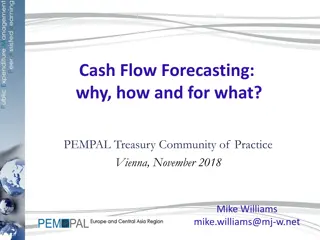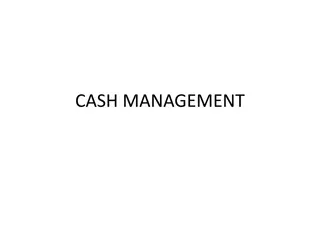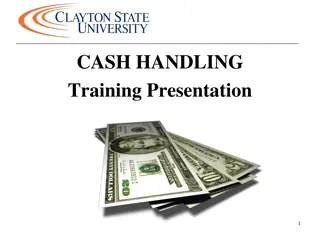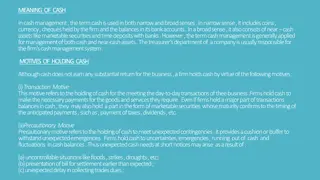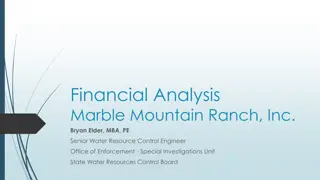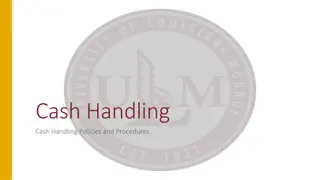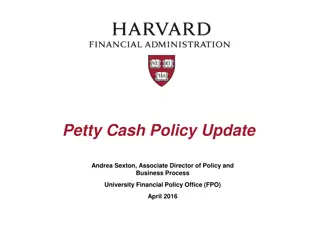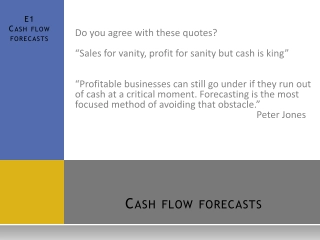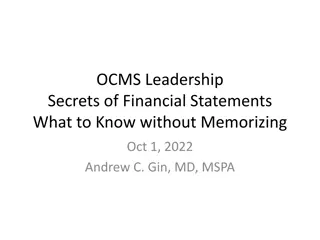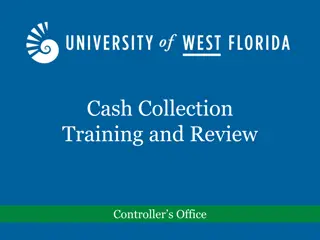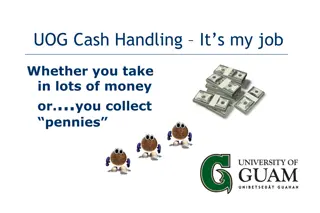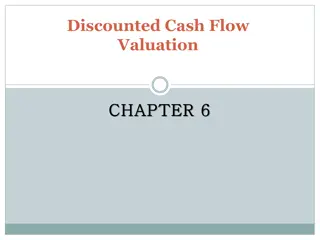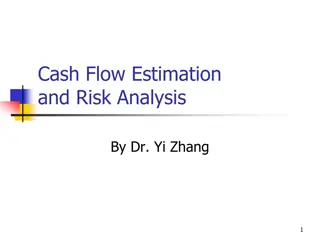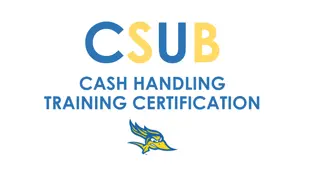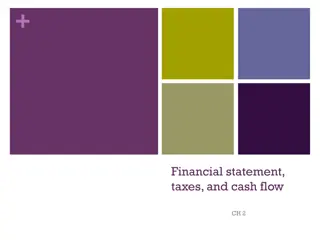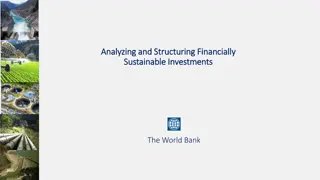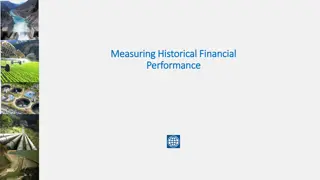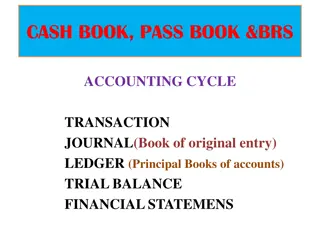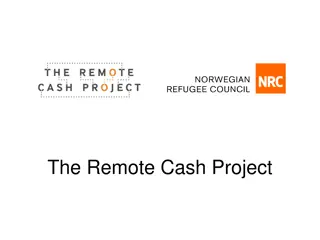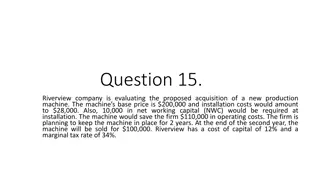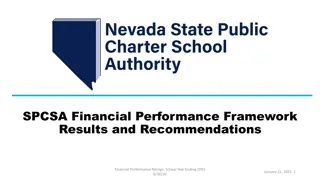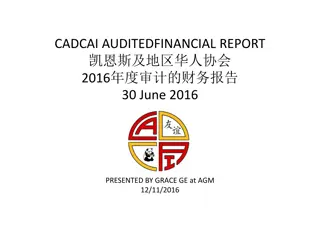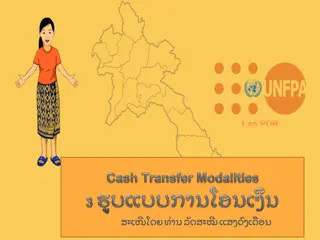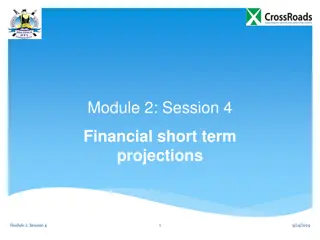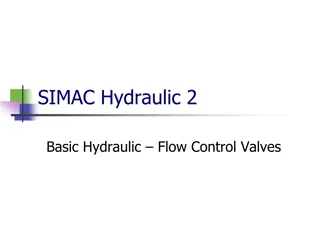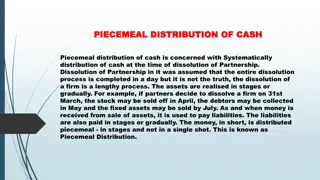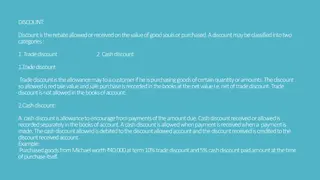Financial Analysis of Shifted Cash Flow Series
Explore the concept of shifted uniform series in financial analysis, including calculations using factors like P/A and P/F to determine present worth values. Learn how to handle uniform series alongside randomly placed single amounts for accurate financial evaluations.
Download Presentation

Please find below an Image/Link to download the presentation.
The content on the website is provided AS IS for your information and personal use only. It may not be sold, licensed, or shared on other websites without obtaining consent from the author. Download presentation by click this link. If you encounter any issues during the download, it is possible that the publisher has removed the file from their server.
E N D
Presentation Transcript
2.4.1 Shifted Uniform Series A shifted uniform series starts at a time other than period 1 The cash flow diagram below is an example of a shifted series Series starts in period 2, not period 1 FA = ? Shifted series usually require the use of multiple factors A = Given 4 2 3 0 1 5 PA = ? Remember: When using P/A or A/P factor, PA is always one year ahead of first A When using F/A or A/F factor, FA is in sameyear as last A 3-1
Example Using P/A Factor: Shifted Uniform Series The present worth of the cash flow shown below at i = 10% is: P0 = ? P1 = ? i = 10% Actual year Series year 0 1 2 3 4 5 6 0 1 2 3 4 5 A = $10,000 Solution: (1) Use P/A factor with n = 5 (for 5 arrows) to get P1in year 1 (2) Use P/F factor with n = 1 to move P1 back for P0in year 0 P0 = P1(P/F,10%,1) = A(P/A,10%,5)(P/F,10%,1) = 10,000(3.7908)(0.9091) = $34,462 3-2
2.4.2 Shifted Series and Random Single Amounts For cash flows that include uniform series andrandomly placed single amounts: Uniform series procedures are applied to the series amounts Single amount formulas are applied to the one-time cash flows The resulting values are then combined per the problem statement The following slides illustrate the procedure 3-3
Example: Series and Random Single Amounts Find the present worth in year 0 for the cash flows shown using an interest rate of 10% per year. PT = ? i = 10% 0 1 2 3 4 5 6 7 8 9 10 A = $5000 $2000 PT = ? i = 10% Actual year 0 1 2 3 4 5 6 7 8 0 1 2 3 4 5 6 7 9 10 8 Series year A = $5000 $2000 Solution: First, re-number cash flow diagram to get n for uniform series: n = 8 3-4
Example: Series and Random Single Amounts PA PT = ? i = 10% Actual year 0 1 2 3 4 5 6 7 8 9 10 0 1 2 3 4 5 6 7 8 Series year A = $5000 $2000 Use P/A to get PA in year 2: PA = 5000(P/A,10%,8) = 5000(5.3349) = $26,675 Move PA back to year 0 using P/F: P0 = 26,675(P/F,10%,2) = 26,675(0.8264) = $22,044 Move $2000 single amount back to year 0: P2000 = 2000(P/F,10%,8) = 2000(0.4665) = $933 Now, add P0 and P2000 to get PT: PT = 22,044 + 933 = $22,977 1-5
Example Worked a Different Way (Using F/A instead of P/A for uniform series) The same re-numbered diagram from the previous slide is used PT = ? FA = ? i = 10% 0 1 2 3 4 5 6 7 8 9 10 0 1 2 3 4 5 6 7 8 A = $5000 $2000 Solution: Use F/A to get FA in actual year 10: FA = 5000(F/A,10%,8) = 5000(11.4359) = $57,180 Move FA back to year 0 using P/F: P0 = 57,180(P/F,10%,10) = 57,180(0.3855) = $22,043 Move $2000 single amount back to year 0: P2000 = 2000(P/F,10%,8) = 2000(0.4665) = $933 Now, add two P values to get PT: PT = 22,043 + 933 = $22,976 Same as before As shown, there are usually multiple ways to work equivalency problems 3-6
2.4.3 Shifted Arithmetic Gradients Shifted gradient begins at a time other than between periods 1 and 2 Present worth PG is located 2 periods before gradient starts Must use multiple factors to find PT in actual year 0 To find equivalent A series, find PT at actual time 0 and apply (A/P,i,n) 3-7
Example: Shifted Arithmetic Gradient John Deere expects the cost of a tractor part to increase by $5 per year beginning 4 years from now. If the cost in years 1-3 is $60, determine the present worth in year 0 of the cost through year 10 at an interest rate of 12% per year. i = 12% PT = ? Actual years 1 10 3 0 2 4 5 Gradient years 0 1 2 3 8 60 60 60 65 70 95 G = 5 Solution: First find P2 for G = $5 and base amount ($60) in actual year 2 P2 = 60(P/A,12%,8) + 5(P/G,12%,8) = $370.41 P0 = P2(P/F,12%,2) = $295.29 Next, move P2 back to year 0 PA = 60(P/A,12%,2) = $101.41 Next, find PA for the $60 amounts of years 1 and 2 Finally, add P0 and PA to get PT in year 0 PT = P0 + PA = $396.70 3-8
PT = ? i = 12% Actual years 1 10 3 0 2 4 5 0 1 2 3 8 Gradient years 0 1 2 ? Series years 60 60 60 65 70 95 3-9
2.4.4 Shifted Geometric Gradients Shifted gradient begins at a time other than between periods 1 and 2 Equation yields Pg for all cash flows (base amount A1 is included) Equation (i g): Pg = A 1{1 - [(1+g)/(1+i)]n/(i-g)} For negative gradient, change signs on both g values There are no tables for geometric gradient factors 3-10
Example: Shifted Geometric Gradient Weirton Steel signed a 5-year contract to purchase water treatment chemicals from a local distributor for $7000 per year. When the contract ends, the cost of the chemicals is expected to increase by 12% per year for the next 8 years. If an initial investment in storage tanks is $35,000, determine the equivalent present worth in year 0 of all of the cash flows at i = 15% per year.
Gradient starts between actual years 5 and 6; these are gradient years 1 and 2. Pg is located in gradient year 0, which is actual year 4 Pg = 7000{1-[(1+0.12)/(1+0.15)]9/(0.15-0.12)} = $49,401 Move Pg and other cash flows to year 0 to calculate PT Next, find PA for the $7000 amounts of years 1 and 4 Next, find P0 for at year 0 , PT = 35,000 + 7000(P/A,15%,4) + 49,401(P/F,15%,4) = $83,232 1-12
Negative Shifted Gradients For negative arithmetic gradients, change sign on G term from + to - General equation for determining P: P = present worth of base amount - PG Changed from + to - For negative geometric gradients, change signs on both g values Changed from + to - Pg = A1{1-[(1-g)/(1+i)]n/(i+g)} Changed from - to + All other procedures are the same as for positive gradients 3-13
Example: Negative Shifted Arithmetic Gradient For the cash flows shown, find the future worth in year 7 at i = 10% per year PT = ? PG = ? FG = ? , FT = ? i = 10% Actual years 0 1 2 3 4 5 6 7 0 1 2 3 4 5 6 Gradient years 450 500 550 600 650 700 G = $-50 Gradient G first occurs between actual years 2 and 3; these are gradient years 1 and 2 Solution: PG is located in gradient year 0 (actual year 1); base amount of $700 is in gradient years 1-6 PG = 700(P/A,10%,6) 50(P/G,10%,6) = 700(4.3553) 50(9.6842) = $2565 FG = PG(F/P,10%,6) = 2565(1.7716) = $4544 3-14 PT =PG (P/F,10%,1) FT =PT (F/P ,10%,7)
2.5 Factor Values for Untabulated i or n 3 ways to find factor values for untabulated i or n values Use formula Use spreadsheet function with corresponding P, F, or A value set to 1 Linearly interpolate in interest tables Formula or spreadsheet function is fast and accurate Interpolation is only approximate 2-15
Example: Untabulated i Determine the value for (F/P, 8.3%,10) OK Formula: F = (1 + 0.083)10 = 2.2197 OK Spreadsheet: = FV(8.3%,10,,1) = 2.2197 Interpolation: 8% ------ 2.1589 8.3% ------ x 9% ------ 2.3674 x = 2.1589 + [(8.3 - 8.0)/(9.0 - 8.0)][2.3674 2.1589] = 2.2215 Absolute Error = 2.2215 2.2197 = 0.0018 , 0.08 % 2-16
Unknown Recovery Period n Unknown recovery period problems involve solving for n, given i and 2 other values (P, F, or A) (Like interest rate problems, they usually require a trial & error solution or interpolation in interest tables) Procedure: Set up equation with all symbols involved and solve for n A contractor purchased equipment for $60,000 that provided income of $8,000 per year. At an interest rate of 10% per year, the length of time required to recover the investment was closest to: (a) 10 years (b) 12 years (c) 15 years (d) 18 years Can use either the P/A or A/P factor. Using A/P: Solution: 60,000(A/P,10%,n) = 8,000 (A/P,10%,n) = 0.13333 From A/P column in i = 10% interest tables, n is between 14 and 15 years Answer is (c) 2-17
Unknown Interest Rate i Unknown interest rate problems involve solving for i, given n and 2 other values (P, F, or A) (Usually requires a trial and error solution or interpolation in interest tables) Procedure: Set up equation with all symbols involved and solve for i A contractor purchased equipment for $60,000 which provided income of $16,000 per year for 10 years. The annual rate of return of the investment was closest to: (a) 15% (b) 18% (c) 20% (d) 23% Solution: Can use either the P/A or A/P factor. Using A/P: 60,000(A/P,i%,10) = 16,000 (A/P,i%,10) = 0.26667 Answer is (d) From A/P column at n = 10 in the interest tables, i is between 22% and 24% 2-18



